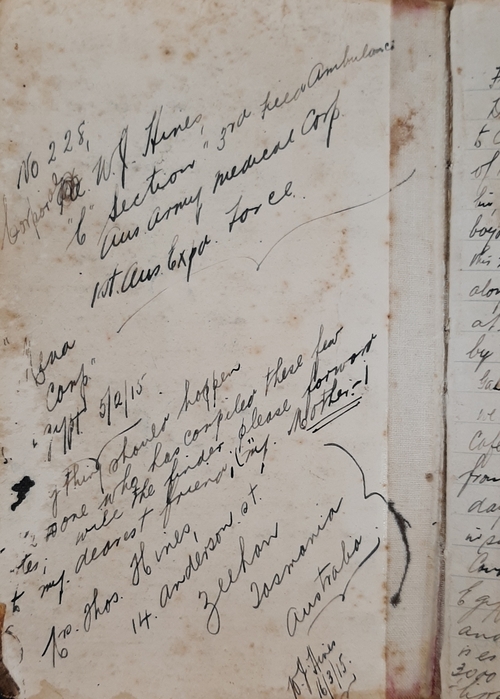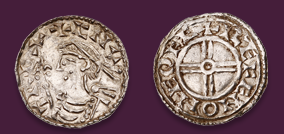Auction: 25112 - Orders, Decorations and Medals - e-Auction
Lot: 906
A pair of unpublished diaries written by Corporal W. J. Hines, 3rd Field Ambulance, Australian Army Medical Corps, later Lieutenant 15th Battalion, Australian Imperial Force
Who was present with the Fleet escorted by H.M.A.S. Sydney when she steamed into Battle at the Cocos Islands later seeing the wonders of Egypt and witnessing the landing at ANZAC Cove
He was commissioned, joined the 15th Battalion in France and tragically died of wounds in August 1918
Two leather bound diaries, covering the period 26 September 1914 - 8th January 1916, the recipient's name, rank and unit are written on the inside cover, somewhat battered and foxed, with minor water damage in places however legible, overall nearly very fine (2)
Walter John Hines was a native of Brunswick, Melbourne, he begins his first diary with his embarkation on the SS Geelong on 27 September 1914. They steamed to other ports in Tasmania before joining the convoy guarded by the HMAS Sydney on which steamed for the Mediterranean in November 1915. He describes the journey:
'Our Convoy's position was also changed now, & we have the Minotaur leading, Pyramus, scouting, Syndey portside, Japanese cruiser [Ibuke] starboard side, Melbourne in rear with the Physohe [SIC] scouting.'
Hines' recollection of the convoy in the hours of 9th November which saw the Sydney batter the Emden into submission are somewhat confused. The men aboard the troopships had only fragmentary news of what was happening and indeed they had no idea where many of the ships were with Hines at one stage lamenting that he could see only 'the 38 troopships of our convoy & the vast ocean'. However soon the news landed, Hines' excitement is palpable in his retelling which states:
'… Melbourne was sending the Morse signal every now & again. All eyes were on the two warriors & […] to see something of a battle & at 12 noon news came through from the Sydney (per wireless) that the Sydney had caught the German "Emden" the ocean pest of the German fleet & had left her in a sinking condition on the beach of the Cocos Islands.
The joy & excitement was intense for some time & we all pleased [SIC] also proud to know that one of our Australian cruisers had been so successful in the first engagement she has had & now we feel we are much safer now that the Emden is out of our rear & details of the engagement is meagre but we know our convoy have done something exceptionally good…'
He learned more when the ship reached Columbo but continued the journey, recording unusual sights along the way. His first Diary entry ends with disembarking in Egypt in December 1914, taking the time to tour the ancient sites, most notably the pyramids which his guide informed him were built by 'King Khufu or Cheops'.
After some time spent in Egypt he embarked with the SS Nizam for the Dardanelles on 1 March 1915. They landed at Lemnos on 10 March where Hines spent much of his time aiding the various Allied Battalions disembarking. He saw various naval engagements but was not present for the final great effort of the Allied fleet to take the straights by sea.
The day before the Landings at ANZAC Cove he wrote as follows:
'A feeling of what is likely to be true seems to run through us all, for on the morrow our boys will be under heavy fire'
Hines was somewhat embarrassed to have fallen asleep before the landing and as such missed the first moments, only awakening at 05:00 some half an hour into the attack. His ship was anchored 8 miles off shore waiting for enough room to be secured for the Casualty Clearing Stations to be established. He managed to interview an officer's servant who returned to the troopship at one stage:
'… he replied "Yes boys are doing well. Have taken 2 lines of trenches. Captured some guns." Was after many casualties". He replied "yes casualties very heavy".'
Transferring to the Auxiliary Hospital Ship Galaka he suffered a hair raising journey over to her with shells falling all around. Upon reaching the ship he records:
'We commenced our work, 12-30 noon; dinner was out of the question, men wounded and suffering come in for first thought; we work like Trojans down in […] casualty rooms also used as an operation room it was in ordinary times used as a 2nd […] dining room.'
In his capacity working aboard a hospital ship Hines travelled around much of the Mediterranean but did indeed go ashore several times at Gallipoli. His Diary concludes on 8 January 1916 however his career was by no means over as he was advanced Sergeant and posted to the 4th Divisional Headquarters on 3 August 1916. Successfully applying for a commission he was commissioned 2nd Lieutenant on 28 March 1917, later being posted to the 15th Battalion, Australian Imperial Force.
With them he was wounded on 13 June 1917 but recovered to be advanced Lieutenant on 16 September 1917. A letter for the Adjutant of 15th Battalion Lieutenant Willson, sheds a light upon Hines' eventual fate, stating:
'Lieut W. J. Hines died from wounds received at Vaire-Sous-Corbie on morning August 6th 1918. Wounds were caused by a shell which burst about 20 yards from where Lt Hines was standing.
He was badly hit about the legs and back and died on the way to the Dressing Station.'
Hines is buried at Corbie Communal Cemetery Extension; sold together with copied research.
Subject to 20% VAT on Buyer’s Premium. For more information please view Terms and Conditions for Buyers.
Sold for
£350
Starting price
£210







